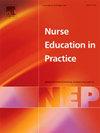初级护理教育融入本科护理课程:范围综述
IF 3.3
3区 医学
Q1 NURSING
引用次数: 0
摘要
目的研究本科护理专业初级保健教育的相关文献,描述初级保健教育的属性和范围。注册护士在跨学科的初级保健模式中是必不可少的。然而,目前尚不清楚初级保健如何以及在多大程度上包括在本科护理计划中,以准备这一劳动力。为了告知这一实践领域并支持教育,有必要更好地了解本科课程中初级保健教育的属性和程度,并确定证据中的差距。设计乔安娜布里格斯研究所范围审查。方法我们的目的是找出已发表/未发表的评估初级保健教育融入本科护理课程的文献。如果研究参与者是教师/管理人员、导师或本科实习护理项目的学生,则文章符合条件。我们检索了CINAHL Plus, MEDLINE, Embase, ERIC, APA PsycInfo, ProQuest disserts and Theses和灰色文献来源。结果共纳入50篇文献。初级保健教育包括两大类:专门的初级保健课程途径和普遍的综合初级保健教育。报告了各种教学和实践活动。障碍/促进因素包括资源可用性;课程;以及教师和导师的特点。在10篇文章中,使用经过验证的工具来测量初级保健教育的结果;然而,很少是针对初级保健的。结论不同专业的初级护理教育的性质和程度不同。该审查强调了需要减轻或利用的潜在障碍/促进因素,以促进初级保健教与学。它总结了可用来评估结果的工具,并指出需要进一步研究和开发方法。本文章由计算机程序翻译,如有差异,请以英文原文为准。
Integration of primary care education into undergraduate nursing programs: A scoping review
Aim
To examine literature related to primary care education in undergraduate nursing programs and to describe the attributes and extent of primary care education.
Background
Registered Nurses are essential within interdisciplinary models of primary care. However, it is unclear how and to what extent primary care is included in undergraduate nursing programs to prepare this workforce. To inform this practice area and support education, there is a need to better understand the attributes and extent of primary care education in undergraduate programs and identify gaps in evidence.
Design
Joanna Briggs Institute scoping review.
Methods
We aimed to identify published/unpublished literature evaluating the integration of primary care education into undergraduate nursing programs. Articles were eligible if study participants were faculty/administrators, preceptors, or students in undergraduate entry-to-practice nursing programs. We searched CINAHL Plus, MEDLINE, Embase, ERIC, APA PsycInfo, ProQuest Dissertations and Theses and grey literature sources.
Results
Fifty articles were included. Primary care education comprised two broad categories: specialized primary care curricular pathways and generalized integrated primary care education. Various didactic and practical activities were reported. Barriers/facilitators included resource availability; curriculum; and faculty and preceptor characteristics. Validated tools were used to measure outcomes of primary care education in 10 articles; however, few were primary care-specific.
Conclusions
The nature and extent of primary care nursing education varies across programs. The review highlights potential barriers/facilitators to be mitigated or leveraged to promote primary care teaching-learning. It summarizes tools available to evaluate outcomes and indicates a need for further research and methodological development.
求助全文
通过发布文献求助,成功后即可免费获取论文全文。
去求助
来源期刊

Nurse Education in Practice
NURSING-
CiteScore
5.40
自引率
9.40%
发文量
180
审稿时长
51 days
期刊介绍:
Nurse Education in Practice enables lecturers and practitioners to both share and disseminate evidence that demonstrates the actual practice of education as it is experienced in the realities of their respective work environments. It is supportive of new authors and will be at the forefront in publishing individual and collaborative papers that demonstrate the link between education and practice.
 求助内容:
求助内容: 应助结果提醒方式:
应助结果提醒方式:


